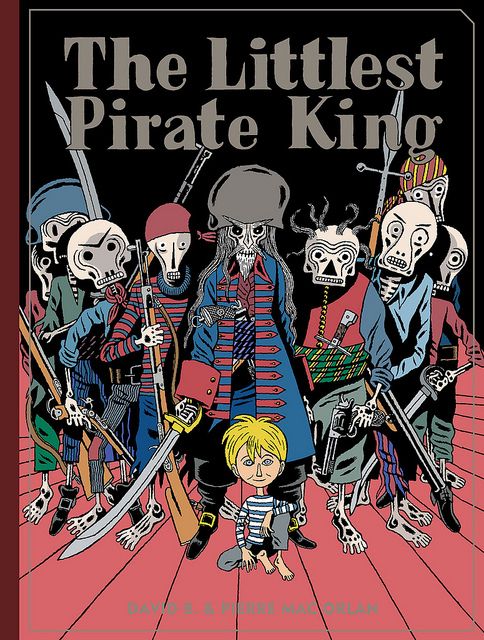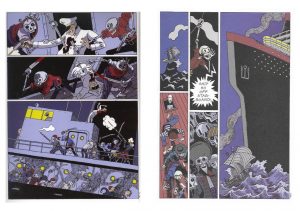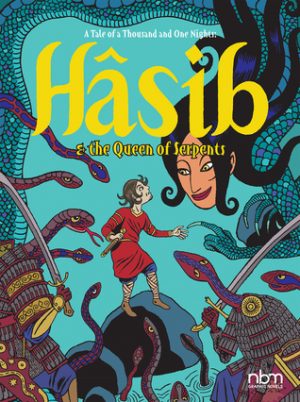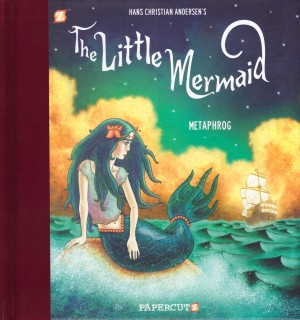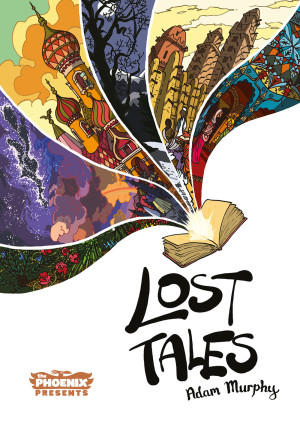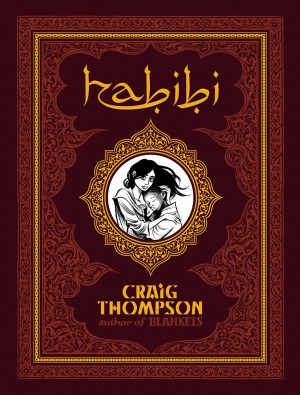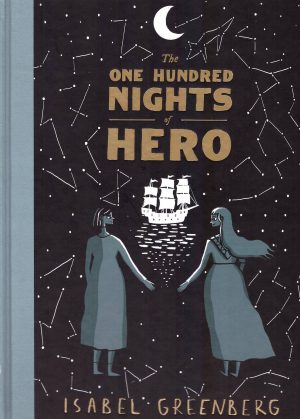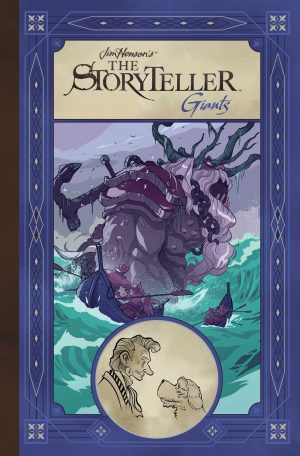Review by Graham Johnstone
David B has a highly distinctive art style that he’s successfully applied to memoir, political non-fiction, and his dreams. The Littlest Pirate King is something different again, an adaptation of a story by bohemian polymath Pierre Mac Orlan. Originally published in France under publisher Gallimard’s children’s imprint, this English edition carries the main Fantagraphics logo, and reads as an all-ages book.
The Littlest Pirate King is the story of the undead crew of legendary ghost ship The Flying Dutchman. The first half of this graphic novella establishes Captain Peter Maus and his crew of ‘five-score’ undead. Piracy no longer fulfils them, as illustrated by their gathering round their trove of plundered consumer goods, before dumping it all overboard. Original author Mac Orlan’s avant-garde roots are evident in the Surrealist collision of opposites (pirates and baby), and the bleak absurdism of the crew’s ever-thwarted bids for oblivion. However, pirates and the undead have strong kid-appeal (see Corpse Talk), bolstered by the washing up at their ship of healthy pink infant boy. This presents the pirates with practical and philosophical challenges, so taking the Dutchman legend in a quite different direction.
Commentators familiar with Mac Orlan’s original note David B’s faithful adaptation, and illustration. The original, being a short story, needs no abridging, and even in 44 pages, David B has ample space to stage each scene.
The art is reliably dazzling. B’s expressive, gently caricatured figures, are at their most concise, charming, and child-friendly. A highlight captures The Dutchman teetering atop a massive ‘Hokusai wave’, as a cloud dances above (pictured, right) as he makes the most of the panel layout and size. The eyes’ movement up and down those stacked vertical panels evoke the ship and crew spilling around in the turbulence, and we follow the Captain’s gaze from the foot of the page up at the ocean liner towering over them. There’s a treasure trove of large panels, enabling scene-setting, and high impact visuals like sea-serpents and other maritime perils. Children will be immersed in the story, as should adults, who will also appreciate David B’s consummate craft.
David B is master of monochrome, ranging elsewhere from binary black and white, to mechanical tones, and ink washes, but his rare use of colour here will further widen appeal. His palette evokes an apt perpetual twilight, perhaps via an overlaid shade. However this may be the cause of murky yellows, and the ‘pink king’ (of the French title Roi Rosé) appearing disturbingly purple. The latter undercuts the central motif of the pink child’s fresh life amongst the centuries-shrivelled skin of the undead pirates. That could have been easily fixed, but against the strength of every vivid panel, it’s a minor quibble.
Translation from the French is by the late Fantagraphics mainstay Kim Thompson. It’s hard to assess translation if unable to (fluently) read the original. However, his interpretation of French title Roi Rosé as The Littlest Pirate King, suggests an wise emphasis on the lyrical over the literal, and it all reads smoothly.
This is an ingenious and affecting twist on a legend, rendered into comics by an acknowledged master. Kids will love it, adults should too, but may be better approaching David B with Epileptic, or Nocturnal Conspiracies. Closest to the current volume is his Hâsib & The Queen of Serpents, a folk tale from 1,001 Nights, and also in colour
